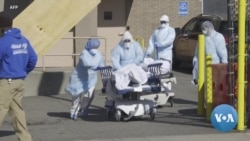ທຳນຽບຂາວໄດ້ຄາດຄະເນການເສຍຊີວິດເກືອບ 82,000 ຍ້ອນ COVID-19 ໃນ ສະຫະລັດ ໃນຕົ້ນເດືອນສິງຫານີ້, ເຊິ່ງຕໍ່າກວ່າຕົວເລກ ທີ່ເປັນຕາຢ້ານ ຈາກການຈຳລອງການລະບາດທີ່ໄດ້ລະບຸໄວ້ກ່ອນໜ້ານີ້. ບັນດາຜູ້ຊ່ຽວຊານເວົ້າ ວ່າ ຄວາມໂປ່ງໄສຂອງລັດຖະບານແມ່ນຈຳເປັນ ໃນການສື່ສານກັບສາທາລະ ນະ ໃນລະຫວ່າງວິກິດການດ້ານສຸຂະພາບ ແຕ່ໄດ້ເຕືອນວ່າການຈຳລອງໂຣກ ລະບາດ ແມ່ນບໍ່ເຄີຍຖືກຕ້ອງແນ່ນອນ. ນັກຂ່າວວີໂອເອປະຈຳທຳນຽບຂາວ ແພັດຊີ ວິດາຄຸສວາຣາ ມີລາຍງານ ເຊິ່ງ ພຸດທະສອນ ຈະນຳລາຍລະອຽດ ມາສະເໜີ ທ່ານໃນອັນດັບຕໍ່ໄປ.
ພາບທີ່ໜ້າເຈັບປວດທີ່ສະແດງໃຫ້ເຫັນບັນດາພະນັກງານການແພດ ຂົນສົ່ງສົບ ໄປຫາລົດບັນທຸກຕູ້ແຊ່ໃນລັດນິວຢອກ, ເຊິ່ງຖືກນຳມາໝູນໃຊ້ເປັນໂຮງເຢັນຊົ່ວ ຄາວ, ໃນຂະນະທີ່ການເສຍຊີວິດຍ້ອນ COVID-19 ໄດ້ຖີບຕົວຂຶ້ນ.
ປະທານາທິບໍດີ ດໍໂນລ ທຣຳ ກ່າວວ່າ “ນີ້ຄົງຈະເປັນອາທິດທີ່ຫຍຸ້ງຍາກທີ່ສຸດ ໃນລະຫວ່າງທິດນີ້ ແລະ ທິດໜ້າ. ແລະ ມັນຈະມີຜູ້ເສຍຊີວິດຈຳນວນຫຼາຍ, ເປັນຈັ່ງໂຊກບໍ່ດີ.”
ຄາດວ່າປະເທດຈະປະຕິບັດການແຍກຕົວຫ່າງຈາກສັງຄົມ ໄປຈົນຮອດທ້າຍ ເດືອນພຶດສະພາ, ໜ່ວຍປະຕິບັດການພິເສດ ໂຄວິດ 19 ຂອງທຳນຽບຂາວໄດ້ ຄາດການວ່າຈະມີຜູ້ເສຍຊີວິດຍ້ອນ ໂຄວິດ 19 ເກືອບ 82,000 ຄົນໃນຕົ້ນ ເດືອນສິງຫາ.
ການຈຳລອງຄາດວ່າ ສະຫະລັດ ອາດຕ້ອງການຕຽງນອນໂຮງໝໍ, ເຄື່ອງຊ່ວຍ ຫາຍໃຈ ແລະ ອຸປະ ກອນອື່ນໆໜ້ອຍກວ່າທີ່ໄດ້ຄາດເດົາໄວ້ກ່ອນໜ້ານີ້. ແຕ່ ແນວໃດກໍຕາມ, ບັນດາຜູ້ຊ່ຽວຊານດ້ານສຸຂະພາບໄດ້ເຕືອນ ກ່ຽວກັບ ການເບິ່ງ ໃນແງ່ດີລ່ວງໜ້າ ແລະ ເວົ້າວ່າ ດີທີ່ສຸດແມ່ນກຽມຕົວໃຫ້ພ້ອມ ສຳລັບເຫດການ ທີ່ຮ້າຍທີ່ສຸດ.
ທ່ານ ວິລລຽມ ຊາຟເນີ ຈາກໂຮງຮຽນການແພດ ມະຫາວິທະຍາໄລ ແວນເດີ ບິລທ໌ ໄດ້ກ່າວວ່າ “ການເວົ້າຢ່າງຈິງຈັງນັ້ນຈະຊ່ວຍໃຫ້ພວກເຮົາ, ທັງໃນແງ່ ຂອງອາຊີບ ແລະ ສ່ວນຕົວ, ຄິດຢ່າງຈິງຈັງ ກ່ຽວກັບ ບັນຫານີ້. ມັນຈະຊ່ວຍ ພວກເຮົາກະກຽມທາງຈິດໃຈ ສຳລັບສິ່ງທີ່ຈະເກີດຂຶ້ນໃນຂ້າງໜ້າ.”
ສຳລັບການຈຳລອງໄວຣັສໂຄໂຣນາຂອງເຂົາເຈົ້ານັ້ນ, ທຳນຽບຂາວ ໄດ້ຕິດຕໍ່ ຫາມະຫາວິທະຍາ ໄລຫຼາຍແຫ່ງ, ລວມທັງມະຫາວິທະຍາໄລ ເທັກຊັສ ໃນເມືອງ ອອສຕິນ. ທ່ານນາງ ລໍເຣັນ ມາຍເຢີສ໌ ຫົວໜ້າກຸ່ມນັກຄົ້ນຄວ້າຂອງມະຫາວິທະ ຍາໄລດັ່ງກ່າວ, ໄດ້ກ່າວເນັ້ນວ່າ ການຈຳລອງໂຣກລະບາດແມ່ນເກືອບວ່າຈະບໍ່ ມີຄວາມແນ່ນອນ, ແລະ ການຄາດເດົາທີ່ວ່ານີ້ ແມ່ນບໍ່ຄືກັບການພະຍາກອນ ອາກາດ.
ທ່ານນາງ ລໍເຣັນ ກ່າວວ່າ “ເວລາເຈົ້າພະຍາກອນພາຍຸເຂດຮ້ອນ, ມັນບໍ່ມີຫຍັງ ທີ່ເຈົ້າສາມາດເຮັດໄດ້ ກ່ຽວກັບ ການປ່ຽນເສັ້ນທາງຂອງພາຍຸ. ມັນມີສິ່ງຕ່າງໆ ທີ່ເຈົ້າສາມາດເຮັດເພື່ອປົກປ້ອງຕົນ ເອງ, ແຕ່ເຈົ້າບໍ່ສາມາດປ່ຽນເສັ້ນທາງຂອງ ພາຍຸ. ເມື່ອເຈົ້າຄາດຄະເນວ່າການລະບາດຂອງໂຣກຕິດຕໍ່ ສາມາດນຳໄປສູ່ວິ ກິດການດ້ານສຸຂະພາບ ຫຼື ນຳໄປສູ່ການເສຍຊີວິດຈຳນວນຫຼາຍນັ້ນ, ແທ້ຈິງ ແລ້ວມັນມີຫຼາຍມາດຕະການທີ່ເຈົ້າສາມາດໃຊ້, ສິ່ງທີ່ເຈົ້າສາມາດເຮັດ, ໂດຍສະ ເພາະການດຳເນີນການລ່ວງໜ້າທີ່ໄວພໍ.”
ການຄາດການຕ້ອງອາໄສຂໍ້ມູນທີ່ດີ, ແລະ ບໍ່ແມ່ນທຸກປະເທດຈະມີຄວາມສາ ມາດໃນການຕິດ ຕາມ, ຫຼື ຄວາມມຸ່ງໝັ້ນທາງການເມືອງທີ່ຈະບັນທຶກກໍລະນີທັງ ຫຼາຍຢ່າງແມ່ນຢຳ ແລະ ໂປ່ງໃສ.
ທ່ານ ແດນຽລ ຣຸນດີ, ຈາກອົງການ CSIS ໄດ້ກ່າວວ່າ “ຂ້າພະເຈົ້າຄິດວ່າ ການຂີ້ຕົວະ ກ່ຽວກັບ ຕົວເລກ, ການປິດບັງທາງວິທະຍາສາດ, ການຂັດຂວາງ ແພດໝໍ, ກວດກາສື່ມວນຊົນ, ແມ່ນເວລາທີ່ຜິດທີ່ສຸດທີ່ຈະເຮັດແນວນັ້ນ.”
ເກົາຫຼີໃຕ້ ໄດ້ເປັນນຶ່ງໃນປະເທດທີ່ໄດ້ຮັບຜົນກະທົບໜັກສຸດ ໃນຕອນຕົ້ນໆຂອງ ໂຣກ ລະບາດ, ແຕ່ໄດ້ຖືກຍົກຍ້ອງ ສຳລັບຄວາມມີປະສິດທິພາບ, ການຕອບ ໂຕ້ທີ່ໜັກແໜ້ນຂອງເຂົາເຈົ້າ ທີ່ລວມມີການປະຕິບັດການຢ່າງວ່ອງໄວ ກ່ຽວກັບ ການກວດໂຣກຢ່າງກວ້າງຂວາງ, ແລະ ຢ່າງໝັ້ນຄົງ, ສົ່ງຂໍ້ຄວາມທີ່ໂປ່ງໃສ່ ເຖິງ ສາທາລະນະໃນຕະຫຼອດວິກິດການ.
The White House is projecting close to 82,000 COVID-19 deaths in the United States by early August - a slightly less grim figure than earlier outbreak models indicated. Experts say that government transparency is essential in communicating with the public during this health crisis but warn that pandemic modeling is never precise. White House Correspondent Patsy Widakuswara has this story.
A harrowing sight in New York City, medical workers transporting bodies to refrigerated trucks, repurposed as temporary morgues, as COVID19 deaths climb up.
“This will be probably the toughest week between this week and next week. And there'll be a lot of death, unfortunately.”
Assuming the country implements full social distancing until end of May, the White House coronavirus task force projects close to 82,000 COVID19 deaths by early August.
The model predicts the U.S. may need fewer hospital beds, ventilators and other equipment than previously projected. However, health experts warn against early optimism and say it’s best to prepare for worst case scenarios.
“That serious talk helps all of us, both professionally and personally, to think seriously about this issue. It helps us prepare psychologically for what's ahead.”
For their coronavirus modeling, the White House reached out to a number of universities, including the University of Texas at Austin. Lauren Meyers, head of the university’s research team, underscores that pandemic modelling is almost never precise, and that these projections are not like weather forecasts.
“When you forecast a tropical storm, there's nothing you can do about changing the path of the storm. There are things you can do to protect yourself, but you can't change the course of the storm. When you project that an infectious disease outbreak could lead to a crisis in health care or lead to many, many deaths, there are actually measures you can take, things you can do, especially if you act early enough.”
Projections rely on good data, and not all countries have the tracking capacity, nor the political will to record cases accurately and transparently.
“I think that lying about numbers, suppressing science, suppressing doctors, censoring the media, this is the absolute wrong time to be doing that.”
South Korea was one of the worst-hit countries in the early stages of the pandemic, but has been praised for its effective, aggressive response, that includes a swift implementation of mass-scale testing, and consistent, transparent messaging to the public throughout the crisis.





